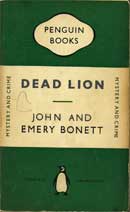 Dead Lion
Dead Lion
John and Emery Bonett
First published by Michael Joseph in the UK 1949
This edition, Penguin Books 1953
213 pages
Source: The bookshelf
Cyprian Druse is a literary lion, a celebrated BBC intellectual, and a feared critic who can make and destroy reputations (he usually destroys – he is respected but by no means popular). As implied by the title, he is also dead. Druse’s American nephew Simon Crane arrives on his doorstep just in time to see the body. Simon has come to London to establish himself as a literary agents and hoped to make the most of his uncle’s contacts.
Druse’s death seems accidental, but Crane soon spots evidence that somebody else was present when he died – a crystal earring and a fragment of the New Statesman. He also finds a potential motive. Druse had encouraged former lovers to make recorded messages for him, and kept the discs to play to selected dinner party guests as an exercise in humiliation.
Six voices, trapped on wax, locked in a cabinet; six women whom he’d persuaded to make fools of themselves in special ways to cheat time of its disillusionment for him, when he ceased to fascinate; six creatures who, once he’d tired of them, once they knew it, would never lie quiet an hour in their beds while they believed those records to exist.
Druse was a cad, in other words, and Simon doesn’t waste time regretting his murder. His main interest is in the owner of one of the voices on his uncle’s records – he has fallen in love at first hearing.
Meanwhile, Professor Mandrake, one of Druse’s circle of radio debaters, is delighted to find that the fatal accident might have been murder.
The lowering features were suddenly lit by a smile of utter delight. ‘But how perfectly wonderful,’ said Mandrake. ‘I’d almost given up hoping something like this could happen to me.’
I gazed at him open-mouthed, as, with an expression of the most innocent happiness, he unsheathed his fountain pen, helped himself to a sheet of Cyprian’s paper, drew it towards him and wrote boldly across the top, ‘New Statesman Murder – first draft.’ Then underneath, spacing the words down the page so that he could fill in the gaps later, he wrote, ‘Time, Clues, Suspects, Motives.’
Simon tolerates rather than encourages Mandrake’s investigation, as it gets in the way of his pursuit of the owner of the voice in question. Mandrake meanwhile gets increasingly grumpy and resentful of Simon’s attempts to evade his investigative efforts. More working at cross-purposes than together, the two men slowly get to the bottom of the affair.
As an investigation this is a pretty thin book, but it’s a nice read and worth picking up as an insight into male-female interaction in the 40s. The outcome of the romance surprised me (a case of the most likely suspect), but equally it is fascinating to see how the characters deal with two different abusive situations. Despite the serious themes, this is quite light-hearted.
Dead Lion is my #1949book for this month’s Crimes of the Century (as I’m now calling the feature where you can review a crime book or film from a particular year – 1949 this May, if you fancy joining in). So how 1949 is it? In a word: rationing. The labyrinthine rules around shopping play a part in establishing an alibi, and result in Mandrake having to rid himself of two surplus ounces of cooking fat. Simon puts on his best Gary Cooper act in the same shop and comes away with ‘soda, washing-powder, soya-getti, and a tin of beetroot’ (which prove on later inspection to be ginger biscuits, cornflower, salad cream and a Canadian Christmas pudding). Soya-getti was new to me, and has a very low profile on Google, but turns out to be a pudding made of jam, bread, butter, raisins and blackberries (apparently).
See also:
Mystery*File: There is very little deduction involved. Persistence and inevitability is all that it takes to reveal the killer, even though more than half the human race would have had a motive, of sorts. What this is, far more than it is a mystery of the traditional type, is a treatise on love and romance.




I tend to find you can’t usually go wrong with a green Penguin – even if you’ve never heard of it, it’s usually readable. And the extracts here sound pretty good!
LikeLike
Excellent review! I had forgotten completely having read this many years ago, but as soon as I saw the cover and the name Cyprian Druse I remembered the book — well, I remembered the basic setup and the fact that I found it lots of fun.
Kaggsy’s right about the “you can’t usually go wrong with a green Penguin” dictum. I had several hundred vintage Green Penguins before I sold them prior to moving to the US (I think most if not all were resold to Maxim Jakubowski’s crime bookshop that used to be at the top of Tottenham Court Road), and there were very, very few duds among them. According to taste, of course — I imagine some here would have little to reward them among the Erle Stanley Gardners, for example.
LikeLike
Green Penguins, huh. I’ve never seen one in real life. We don’t get the Green/Orange editions in California, not in the stores I frequent anyway. But if I do come across one, I’ll pick it up.
LikeLike
I like the Bonetts, I think they wrote nice books, very much of their era. Long time since I read this one… but I think I have that very green Penguin upstairs somewhere….
LikeLike
Pingback: Badass biddies, screaming mimis and, erm, a fur turban: #1949 book | Past Offences Classic Crime Fiction
Pingback: May 2015’s book of the month | Past Offences Classic Crime Fiction